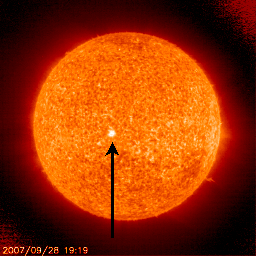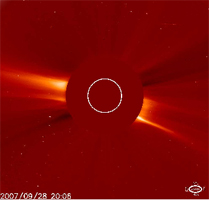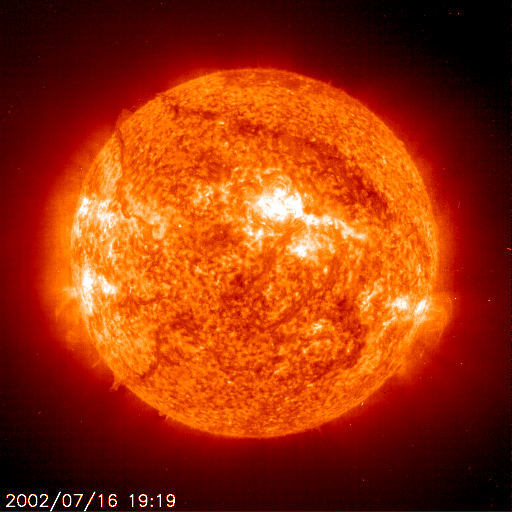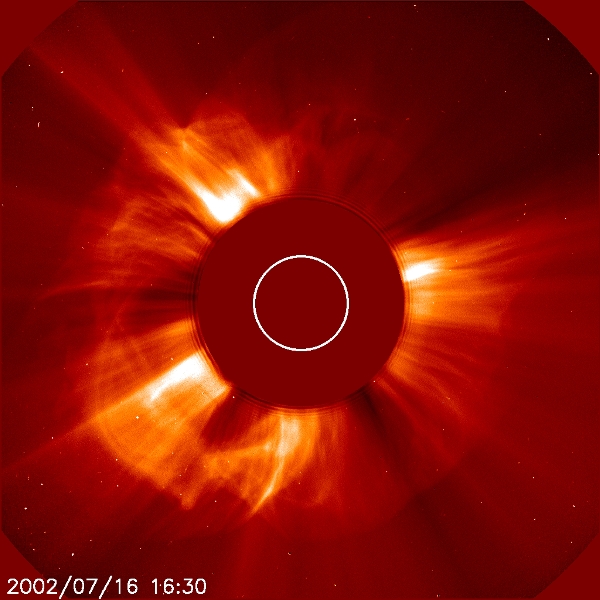

| Science Activities | |||||||||||||||
| Jump to: Coronal Mass Ejection/Magnetosphere Activity | Solar Flare/Ionosphere Activity | |||||||||||||||
Exploring the effect of CMEs on Earth’s Magnetic Field in four steps The main goal of this activity is for students to understand the connection between the magnetic Sun and the magnetic Earth. By going through the various steps, students will have the opportunity to practice with actual images of the sun and real-time magnetosphere data from NASA. |
|||||||||||||||
Step 1: Print the Student Worksheet and Check the Sun If you do not know what a Coronal Mass Ejection (CME) is and you want a short summary rather than visiting the "Background" tab above, read the STEREO CME definition section before viewing today's Sun. Use images from the SOHO and STEREO missions to get a real time (this moment's) view of the Sun from three perspectives (one from SOHO and two from STEREO). Click to go to NASA's Sun Earth Viewer for a view of the Sun from the SOHO satellite. Click to go to NASA's STEREO science center for a view of the Sun's corona from the COR1 instruments on the STEREO satellites, which are ahead and behind the SOHO satellites and ahead and behind Earth in its orbit around the Sun. Write down on the Student Worksheet how many sunspots are on the Sun and if there is a Coronal Mass Ejection coming towards Earth. Relevant resources:
|
|||||||||||||||
Step 2: Calculate A Student K Index Do this by using today’s x-component magnetometer data from at least two magnetometer stations. Write down the average of your values on the Student Worksheet. For instructions on how to calculate a student K index, follow the instructions found on this page. The student podcast “Predicting Auroras by Laura McKay” found on the THEMIS Teacher and Student work page can also be helpful for background on this data and how to calculate the K index. For more in-depth background, see the "Space Weather" teacher's guide under "relevant resources" below. Relevant resources:
| |||||||||||||||
Step 3: Check For Auroras If you live in an area where the Northern or Southern Lights (auroras) can be seen, go outside late at night and note if there are auroras. If you are interested in observing an aurora yourself, you can go to the Geophysical Institute's "aurora forecast" page. If you go to the upper left corner of the page, you can change the forecast's "view" to reflect your location. If you are not at the right latitudes to see auroras, then visit the Windows to the Universe website showing what active versus moderate aurora would look like in an all-sky camera. The link to the real-time display is broken on that page, so then visit the real time all-sky camera images (looking up from the ground) in Fairbanks, Alaska to find out if there are auroras in Fairbanks, AK. You must visit this web site when it is dark in Alaska otherwise the cameras are turned off. The cameras also do not operate when the moon is out in Fairbanks. To find out if the cameras are operating, visit the Poker Flat Allsky Camera Operating Times 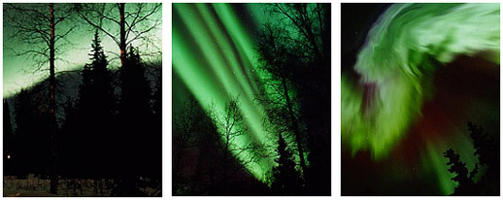
|
|||||||||||||||
Step 4: Data Archive Check out some of the sites below with archived solar and magnetometer data to see if you can make connections between coronal mass ejections, magnetometer signatures, and auroras. Report all your findings on the message board with other students, educators, and scientists. Relevant resources: |
|||||||||||||||
Solar Flares/Ionosphere - Click here to jump to the Solar Flares/Ionosphere Activity As with the CME activity, the goal of this activity is for students to understand the importance of our relationship with the Sun. Whereas CMEs primarily affect Earth's magnetic field, solar flares primarily affect Earth's upper atmosphere. By going through the various steps, students will have the opportunity to practice with solar images and real time ionosphere data from NASA. |
|||||||||||||||
These activities, suggested for students for World Space Week, are taken from these two teacher guides.
|
|||||||||||||||

SEGway is part of the Center for Science Education @ Space Sciences Laboratory, UC Berkeley
©2007 UC Regents
